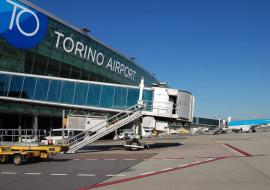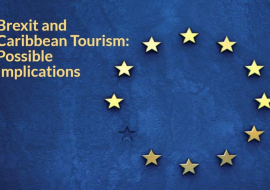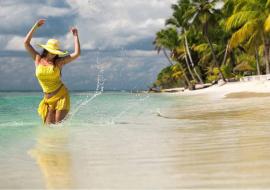The All-Inclusive Evolution

In the midst of what could be remembered as the nickel-and-diming decade for travelers, who have become begrudgingly familiar with checked baggage costs, hidden resort fees, and sky-high WiFi charges, it's no wonder that there is burgeoning demand for a product on the flip side of that.
The all-inclusive resort model is on the rise. Still a small percentage of hotels and resorts overall, the concept is quickly expanding in its Caribbean and Mexican strongholds, as well as in farther-flung, less beach-centric locations.
Brands like Hyatt, once considered too upscale for the all-inclusive model, are getting in on it, and places like St. Martin and Puerto Rico that traditionally discouraged all-inclusives are slowly opening to them.
Adam Stewart, CEO of Sandals Resorts International, predicted that the all-inclusive market would be the fastest-growing segment of the leisure travel industry in the next 10 years.
He may be right. After taking a hit during the recession of 2008, research firm IBISWorld forecasted that all-inclusive vacation revenue would increase at an annual rate of 2.5 percent, to $150.09 million, by 2017. And Robert Cole, PhoCusWright senior research analyst for Lodging and Leisure Travel, estimates overall growth of the sector at between 5 percent and 7 percent.
Travel agents are seeing the same trends on the ground.
Daren Autry, manager of operations, Leisure Division of Montrose Travel, said that all-inclusive bookings "have grown exponentially over the years."
"Eight years ago, we would see the budget traveler and the family who just wanted to make the dollar stretch interested in all-inclusives," Autry said. "Now, you see wealthy people staying at all-inclusive properties, too. There is a greater mixture of people who stay there and options being offered."
The all-inclusive of today is nothing like what some may recall from the early, unruly days of all-inclusives, which started popping up on Caribbean beaches in the 1970s with no business model or game plan. The exception was Club Med, the all-inclusive pioneer, which got the ball rolling in Europe in 1950 with its formula for shared experiences at one set price.
Travelers, particularly singles, flocked to these resorts, captivated by the one-price concept, the hedonistic party atmosphere and the possibility of a quick romance.
Now, some 45-plus years later, the all-inclusive model dominates many resort areas in the Caribbean and Mexico, includes several properties in Europe and is making inroads into Central America, South America, Asia and Africa.
Club Med today has more than 65 resorts around the world, including a growing roster of ski resorts.
Within the Caribbean, there are more than 250 all-inclusive resorts spread over 20-plus Caribbean islands, with Cuba, the Dominican Republic and Jamaica leading the pack.
Mexico's list tops 175 and continues to grow, with the bulk found in the beach resorts of Cancun, Riviera Maya, Puerto Vallarta and Los Cabos. The resorts span more than 35 hotel companies, a number that is expected to grow as new brands test the all-inclusive waters.
"All-inclusives are no longer a niche market but are now a real category," said Xavier Mufraggi, CEO of Club Med North America. "There's big growth in the Caribbean, but also in Asia, where we are launching our fourth property at the end of December."
Growth at AMResorts, a subsidiary of Apple Leisure Group, has been nothing short of spectacular. The 14-year-old company just inked its 15th resort deal since January and will end 2016 with a total of 40 all-inclusives covering six brands in the Caribbean, Mexico, Costa Rica and Panama totaling more than 15,000 rooms. Eight more resorts are slated to open in 2016, and plans extend well beyond that for additional properties.
The Spain-based chain Riu Hotels & Resorts, in addition to its inventory in Europe and beyond, has all-inclusives in Aruba, the Bahamas, Costa Rica, the Dominican Republic, Jamaica and Mexico. Last December, the company opened the first all-inclusive on St. Martin. The dual-country island previously had no all-inclusives on the French side and only three Sonesta all-inclusive properties on the Dutch side of St. Maarten.
Paco Benito, Riu's general manager, admitted it was a challenge, adding, "We're using this first year to see how it all shakes out."
Consumer demand and the upward tick in the appeal of all-inclusives went into Riu's decision, Benito said.
"Because our customers trust Riu to deliver, they are willing to try alternate destinations that feature Riu resorts," he said.
Although a handful of brands dominate the all-inclusive market, that's not preventing new names from jumping into the ring. One of the most surprising of those was Hyatt Hotels International, which last year launched the Hyatt Zilara adults-only resorts and Hyatt Ziva family resorts, both all-inclusive brands.
A case study of one property's decision to offer an all-inclusive option illustrates the extent to which guest demand drives these decisions, even in Puerto Rico, an island that has long been a holdout on all-inclusive resorts.
Hyatt did not fly solo into the all-inclusive market, but acquired a 20 percent stake in Playa Resorts Management, the operational component of Playa Hotels & Resorts, a collection of 14 beach hotels that agreed to rebrand select properties in Mexico and the Caribbean under the Hyatt brands.
The first of them, the Hyatt Zilara Cancun, opened in 2013; since then, the brand has opened the Hyatt Ziva Rose Hall in Jamaica, the Hyatt Ziva in Puerto Vallarta and the Hyatt Ziva Los Cabos. In November, it is scheduled to open the Hyatt Ziva Cancun. Expansion plans could extend beyond the Caribbean and Mexico.
"All-inclusive is not geographically inclusive," said Kevin Froemming, Playa's executive vice president and chief marketing officer.
One of the largest all-inclusive companies is Sandals Resorts International, which encompasses Sandals, Beaches and Grand Pineapple Resorts and totals 20 properties with 5,441 rooms on seven Caribbean islands, with more rooms, resorts and possibly more destinations in the pipeline.
The company has come a long way since Butch Stewart, Sandals' founder and chairman, opened his first all-inclusive, Sandals Montego Bay in 1981.
Sandals has helped drive the evolution of the all-inclusive concept into a luxury vacation segment, one in which increased demand has spurred competition that has resulted in vastly higher quality at every level.
"Globally, the number of travelers booking all-inclusive resorts has motivated hotel companies to raise the bar," said Adam Stewart. "Early on, the segment was bastardized by long buffet lines and two-star accommodations, but today there is no cap to the creativity that exists in refining, defining and extending this market."
The demographics of the all-inclusive product now cater to distinct market segments, from couples and singles to multi-generation families, foodies, health and fitness devotees, honeymooners, active vacationers, millennials, incentive groups and weddings, a trend found in Ernst & Young's Global Hospitality Insights report, which was issued in 2014.
That report pointed out that growing competition among all-inclusive operators "has spurred a quest for product differentiation, resulting in the emergence of brands targeting specific customer types [singles, couples, families, health conscious travelers and sustainability-focused travelers]."
Price points and product offerings run the gamut from bare bones to over-the-top, and many of the all-inclusive properties on the market today are standouts: stunning in decor, top-rate in service and awash in amenities, entertainment, sports and recreational activities.
The offerings at all-inclusives have improved significantly and now include swim-up suites, terrace soaking tubs, fire pits, butler service in the upper room categories, experiential and cultural activities, mobile resort apps, a variety of high-end, a la carte restaurants and wine selections, and pool and beach waiter service.
"The all-inclusive industry has finally caught on to the flight to quality that so many other sectors have experienced," said Mark Lunt, a real estate and hospitality principal at Ernst & Young. "They are delivering a higher-quality experience and closing the gap they had begun to lose to properties" that charge separately for meals and activities.
The most noticeable improvement at all-inclusives is the quality of food and beverage offerings, Ernst & Young reported. Buffet lines of the past have been replaced with high-end restaurants that emphasize local foods and locally sourced ingredients. Basic liquor offerings have been replaced with upscale bars and premium brands.
The higher-quality product has enabled all-inclusives to charge more, which helps alleviate one of the model's biggest weaknesses, according to the Ernst & Young report: the inability to upsell guests and generate additional revenue, as guests are typically locked into certain price points. It has also helped the all-inclusive sector attract the modern traveler.
"Six or seven years ago, people would say, 'Do they have swim- up bar and sufficient lounge chairs around the pool?'" said Rose Gray, manager of business development and vacation sales for Fox World Travel. "Now, people ask me to describe the spa, the wellness and fitness plan. ... People ask about the ingredients in the food, the chef and the wine list."
Travel sellers like Gray welcome the all-inclusive expansion, citing additional demand they say includes a more diverse and more affluent customer; among them are repeat clients who want the all-inclusive experience and to branch out from typical all-inclusive locations. Gray gets excited with each new all-inclusive brand and location.
"Our customers are saying they've been to Cancun and Riviera Maya three and four times," Gray said. "They love the [all-inclusive] concept but say that their expectations have grown as their income has grown. They are looking for something higher end, and now they're looking at Aruba, Costa Rica, even Puerto Rico. Before, they would say, 'What do you mean, there are no all-inclusives in Puerto Rico?' There is one now."
Of course, there are still many places where people won't easily find an all-inclusive, like Hawaii. According to some travel agents, this can make a location less attractive to their clients.
"We've had people even switch from the Hawaii to the Caribbean or Mexico because of the all-inclusive option," said Grace Davis, a personal vacation planner in the Leisure Division of Montrose Travel.
All-inclusives are on the rise, swiftly expanding across their stronghold in the Caribbean and Mexico while being explored by more hotel brands and destinations that are less beach-focused. Pictured here, Mexico is home to more than 175 all-inclusive resorts, including the Iberostar Grand Hotel Paraiso on the Riviera Maya.
Not everyone is so bullish on the all-inclusive market.
Alan Lewis, managing director of the Aviation and Travel practice at Boston-based L.E.K. Consulting, said that the travel habits of the millennial generation could be a headwind to the all-inclusive sector.
"The millennial traveler has a set of priorities that is very distinct from the traditional baby boomer approach to vacationing," Lewis said. "They're interested in being in the now, in the moment, making very spontaneous decisions, having very authentic experiences and experiences they're in control of.
"That challenges the all-inclusive model," he said.
However, Lewis also said that even millennials eventually will grow older and have families.
"They'll have to make compromises in spontaneity," he said. "That's where if you can strike the right balance of convenience and also fulfilling their desire to do something authentic and new, that's an opportunity."
A longtime concern about all-inclusives is that they do not benefit the destinations as much as regular hotels do.
"All-inclusives are not necessarily inherently bad; if done well, they can offer sustainable solutions for high-density tourism," said Sarah Bareham, marketing executive with Responsible Travel. "But if not, they can be very destructive."
One of the biggest issues is the nature of an all-inclusive -- that it includes all food, drinks and activities, so guests don't leave the resort and support the local communities as much as guests staying in an a la carte resort, meaning a smaller percentage of guests' money reaches locals.
However, Bareham said there are all-inclusives that provide abundant quality employment for local people and that do act responsibly in terms of benefitting local communities.
Sandals, for example, is consistently praised for doing just that. The brand makes a concerted effort to support local agricultural communities by sourcing as much of its food locally as possible and encouraging its guests to get out and see the islands where they are, with great success: Sandals Resorts takes about 60 percent of its guests off-property.
"It's a myth with Sandals and the all-inclusive tradition [that we] put people in the hotel and close the gate," said Heidi Clarke, executive director of Sandals' nonprofit arm, the Sandals Foundation. "That's absolutely not true."
Sandals guests, she said, get out and see the islands, whether it's an island fish-fry, a conch fest or just local hot spots.
The Ernst & Young report also found that many all-inclusives now focus on off-site excursions, specifically adventure activities such as zip-lining, diving and hiking.
"Everyone is benefitting from this," Clarke said. "From the taxi man to the tour companies to the restaurants, everyone knows it's Sandals that the guests are coming out from."
Source: Travel Weekly













